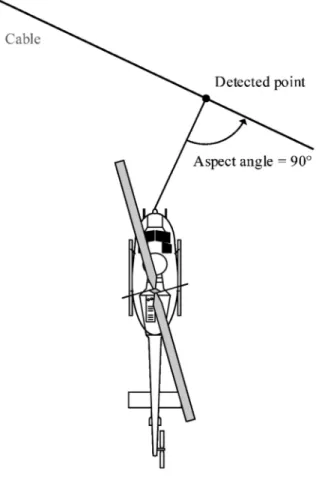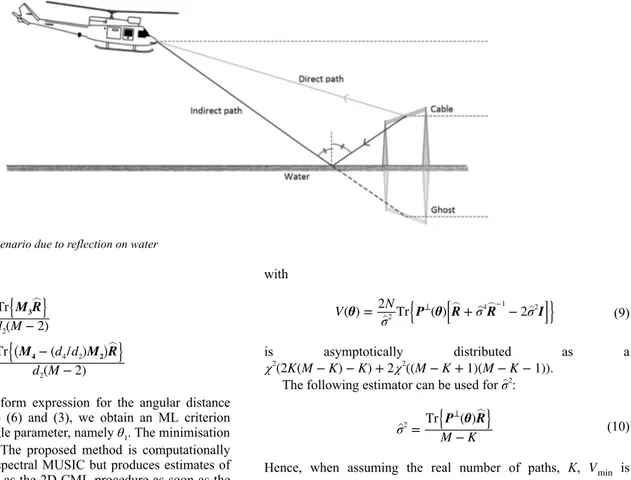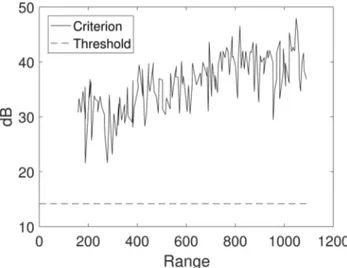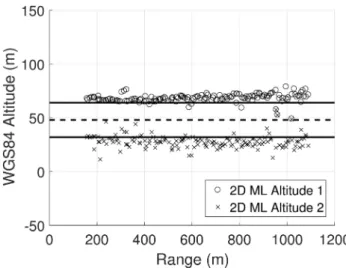HAL Id: hal-01925385
https://hal.archives-ouvertes.fr/hal-01925385
Submitted on 16 Nov 2018
HAL is a multi-disciplinary open access
archive for the deposit and dissemination of
sci-entific research documents, whether they are
pub-lished or not. The documents may come from
teaching and research institutions in France or
abroad, or from public or private research centers.
L’archive ouverte pluridisciplinaire HAL, est
destinée au dépôt et à la diffusion de documents
scientifiques de niveau recherche, publiés ou non,
émanant des établissements d’enseignement et de
recherche français ou étrangers, des laboratoires
publics ou privés.
Robust DoA estimation in case of multipath
environment for a sense and avoid airborne radar
David Bonacci, François Vincent, Benjamin Gigleux
To cite this version:
David Bonacci, François Vincent, Benjamin Gigleux. Robust DoA estimation in case of multipath
environment for a sense and avoid airborne radar. IET Radar Sonar and Navigation, Institution of
Engineering and Technology, 2017, pp.0. �10.1049/iet-rsn.2016.0446�. �hal-01925385�
Robust DoA estimation in case of multipath
environment for a sense and avoid airborne
radar
David Bonacci
1, François Vincent
2, Benjamin Gigleux
31Signal Processing, TESA, – 7 Boulevard de la Gare, 31500 Toulouse, France 2DEOS, ISAE, 10 Avenue Edouard Belin, 31400 Toulouse, France
3Rockwell Collins France, 6 Avenue Didier Daurat, 31700 Blagnac, France
E-mail: david.bonacci@tesa.prd.fr
Abstract: This study deals with the sense and avoid problem for an helicopter. The objective of such a system is to early detect
collision targets (typically high-voltage wires). The direction of arrival (DoA) of the target is then a crucial information. In severe multipath environments (flight over a river, for instance), classical DoA estimation schemes dramatically degrade. The authors make use of a method based on the maximum likelihood (ML) principle that can resolve two highly correlated and close targets. The major drawback of ML algorithms, namely the computational burden, is removed using an approximation for closely space targets. The contribution of this study is twofold. The authors first extend the approximated ML DoA estimation to the case of non-uniform linear antennas and complete the procedure by a detection scheme. Second, they attest the validity of this new processing on real radar data. Hence, they show that the proposed procedure is able to detect a high-voltage wire, over a river, at ranges up to 1 km, where a capon beamformer cannot.
1 Introduction
Nowadays, helicopters are equipped with cable cutters to mitigate the risk of wire strikes while flying at low altitude. The efficiency of cable cutters has been demonstrated for cables with diameter up to 4 mm. However, collisions with cables remain the cause of numerous fatal accidents despite the experience of pilots. Most cables involved in accidents correspond to unmarked power lines, communication wires, cables of aerial tramway, cables for transportation of explosives, or cable yarding systems.
Possible solutions for cable detection systems include optical cameras, lidar and radar operating from X-band to Ku-band. The latter seems to be the most interesting stand-alone solution as it reaches satisfying probability of detection for a given probability of false alarms while covering a wide field of view, operating both day and night, whatever the weather conditions. On the other hand, radar systems only detect a single scattering point of cables, if existing, which is located with an aspect angle of 90° (see [1] and Fig. 1). This problem of wire detection with radar is addressed, for example in [2, 3].
Using an antenna array, various methods can be used to separate this scattering point from ground returns even at long ranges. Common high-resolution algorithms can be considered such as quadratic (e.g. Capon) or subspace methods (e.g. MUSIC). Both provide optimum performances and reach Cramér-Rao Bound (CRB) at high SNR [4]. However, their performances could be significantly degraded when the source signal is correlated with another scattering point.
This situation can unfortunately be observed during flights above rivers. At long ranges and low grazing angles the direct path mixes up with the indirect path bouncing off onto the water.
This multipath is strongly correlated with the direct path, leading to a biased DoA estimation for quadratic and subspace methods, and consequently a possible under-estimation of the wire height.
There are many DoA estimation methods for correlated sources separation. For example, spatial smoothing [5] is a pre-processing technique improving source decorrelation. It can be improved with forward/backward spatial smoothing (FBSS) as in [6, 7] but these techniques require a high number of sensors. Another class of approaches, such as the one introduced in [8, 9], define a grid of
investigated angles and exploit multiple measurement vectors by collecting samples at different time indices. However, these techniques also require a high number of sensors and need to assume that the DOAs are constant within a substantial duration.
ML methods are another class of approaches known to be robust to sources correlation, but require higher computational resources as they operate in a multidimensional space. However, in the case of two sources, the maximisation of the likelihood function can be simplified and reduced to a simpler one-dimensional search [10, 11]. Moreover, effective and computationally light methods can be used to estimate the number of correlated sources. In this paper, we have adapted such a scheme to detect the number of multipaths. It can be noticed that these kinds of method work also in the case of rank deficient correlation matrices [12].
Moreover, we have extended the algorithm to the case of non-uniform linear arrays to be compatible with future radar front-end evolutions. Its performance has been compared to conventional methods on real data, collected with an X-band radar from an helicopter flying above a river where a cable was hanging above the water. Achieved results have been significantly improved in comparison with conventional methods.
The paper is built as follows: Section 2 presents the model at hand and our proposed scheme to deal with the multipath problem. Test scenarios description and comparison of performance are carried out in Section 3. Section 4 concludes the paper.
2 Theoretical background
2.1 Model and assumptionsThe problem of finding the DoA of K narrow band planar waves using an array of M sensors can be expressed as the estimation of a vector parameter θ using the model:
x(t) = A(θ)s(t) + n(t), t = 1, 2, …, N (1) where x(t) ∈ ℂM× 1 are the vectors of observed sensor outputs (snapshots), s(t) ∈ ℂK× 1 are the unknown source signals,
n(t) ∈ ℂM× 1 is an additive noise, θ= θ
information to be estimated, and A(θ) ∈ ℂM×K is composed of the steering vectors a(θk) from each source direction:
A(θ) = a(θ1) ⋯ a(θK) (2) We consider the following assumptions [13]:
• M ≥ K (at least as many sensors as sources) and A is supposed
to be full rank (sources cannot be exactly collocated in the same direction).
• The additive noise vector n(t) is assumed Gaussian with zero mean, circular complex symmetric, spatially and temporally white: E[n(t1)n(t2)H] = σ2Iδt2 −t1 and E[n(t1)n(t2)T] = 0, ∀t1, t2. • s(t) is unknown deterministic complex variables.
As stated in Introduction, classical high-resolution techniques such as Capon or MUSIC are known to be very sensitive to sources correlation. As we are dealing with a scenario comprising possible multipath, we turn towards a more complicated but more robust method – the ML procedure.
2.2 Maximum likelihood DoA estimation
2.2.1 Exact maximum likelihood estimation: Two kinds of ML
criteria can be developed from model (1) depending on the signal sources assumption. If the signal sources are considered as unknown deterministic, the ML procedure will lead to the so-called conditional maximum likelihood (CML), whereas if the signal sources are considered as Gaussian random variables, the ML will result in the so-called unconditional maximum likelihood (UML) [13]. In this paper, we assume that the signal sources are deterministic signals, leading to the CML criterion to be minimised:
θCML= argminθTr P⊥R (3)
where P is the projection operator onto the subspace spanned by
the columns of A(θ) (signal subspace):
P= A(θ) AH(θ)A(θ)−1
AH(θ) (4)
and P⊥= I − P is the projection onto the noise subspace. This
CML estimate is not strictly asymptotically efficient, that is to say that it does not tends exactly towards the CRB given in (5) when the number of snapshots tends towards infinity because the number of unknowns increases as fast as N [13]. On the other hand, it is simpler than the UML and it is more general as it does not assume any hypothesis on s(t) behaviour.
BC= σ2N Re(R2 S⊙ HT)
−1
(5) where Re[ ] is the real part, RS= (1/N)∑tN= 0− 1s(t)s(t)H, ⊙ stands for the Hadamard (elementwise) product of two matrices and
H= ΔHP⊥Δ with Δ = (∂a/∂θ
1), (∂a/∂θ2), …, (∂a/∂θK) .
2.2.2 Approximate CML for two closely spaced targets: Even
in the case of two sources only, one has to solve a non-linear multidimensional optimization problem to estimate the DoA using the CML method (3), which can be computationally expensive. To reduce this complexity, authors in [10, 11] proposed a Taylor series expansion of the projection matrix P valid in the case of two
sources with close DoAs and for uniform linear array. This approximation allows to simplify the 2D-minimisation into a simpler 1D search.
In this paper, we generalise this procedure to the case of non-uniform linear array (NULA).
When using NULA, the problem cannot be formulated as a function of spatial frequencies anymore (as in [10] or [11]). Instead, we parametrise the problem using sin θ1 and Δsinθ= sin θ1− sin θ2 directly:
x(t) = A(sin θ1, Δsinθ)s(t) + n(t), t = 1, 2, …, N
with a(sin θ1) = [1, …, e
(2iπzk/λ)sinθ1]T, where the M sensors of the
NULA are located at positions z0= 0, z1, z2, …, zM− 1 and λ is the wavelength. Conducting a Taylor series expansion for small Δsinθ, and after some straightforward calculation, we obtain
P≃ − 1d 2 M2+ M3Δsinθ+ M4− d4 d2M2Δsinθ 2 + o(Δ sinθ 3 ) (6) where dn=
∑
k = 0 n ckcn∗−k ck=Tr DMk Dk= (2iπ)k λkk! diag 0k, z1k, …, zkM− 1 Mn=∑
k = 0 n Dka(sin θ1)a(sin θ1)HDHn−k−cka(sin θ1)a(sin θ1)HDnH−k− ck∗Dn−ka(sin θ1)a(sin θ1)H Substituting (6) in (3) (retaining only the terms up to Δsinθ2 ) and differentiating with respect to Δsinθ, we obtain the following closed-form expressions for the difference:
ΔsinθACML(sin θ
1) ≃ −
α1
2α2 (7)
where α1= Tr M3R d2(M − 2) α2= Tr M4− (d4/d2)M2R d2(M − 2)
Substituting this closed-form expression for the angular distance between the targets into (6) and (3), we obtain an ML criterion depending only on a single parameter, namely θ1. The minimisation is then straightforward. The proposed method is computationally equivalent to Capon or spectral MUSIC but produces estimates of the two DoAs as precise as the 2D CML procedure as soon as the two paths are close. Moreover, like the ML procedure, we can expect a robust behaviour to source correlation. However, this algorithm assumes the presence of two sources, namely the direct path and a close reflected path in our case of interest. This hypothesis has to be verified beforehand in a first step, this is the objective of the next sub-section.
2.3 Detection of the number of paths
Detecting the presence of multipath for a low-elevation target can be seen as a special problem of detecting the number of sources, with two more difficulties:
• the possible two sources viewed from the radar are strongly correlated or nearly coherent
• the DoA of the two sources is close.
In case of non-correlated targets, determining the number of sources is a classical problem in array processing. Many popular techniques based on the analysis of the eigenvalues of the correlation matrix can be used (Akaike's information criterion (AIC), minimum description length (MDL) and eigenvalue gradient methods (EGM)) [14, 15]. In case of coherent sources, on the other hand, there is almost a linear relationship between the signals from these sources [6], resulting in a rank reduction of the correlation matrix. Therefore the previous kind of techniques, based on the eigenvalues decomposition, often fail to detect the presence of multipath. In [6, 7], FBSS is proposed as a pre-processing technique to improve source decorrelation. However, these techniques require a high number of sensors.
Authors in [12] have proposed methods based on joint detection and estimation to directly estimate the number of sources, rather than the dimension of the signal subspace. The principle is as follows. Let K be the assumed dimension of vector θ in model (1)
(number of sources). The technique proposed in [12] is based on the following result: if K = K and σ2 is a consistent estimator of σ2, then Vmin= Min θ V(θ) (8) with V(θ) = 2Nσ2Tr P⊥(θ) R + σ4R −1 − 2σ2I (9) is asymptotically distributed as a χ2(2K(M − K) − K) + 2χ2((M − K + 1)(M − K − 1)). The following estimator can be used for σ2:
σ2= Tr P⊥(θ)R
M − K (10)
Hence, when assuming the real number of paths, K, Vmin is minimal and we actually know its probability density function. On the contrary, for a false hypothesis on the number of paths, the residual Vmin increases. Therefore, we can construct a binary hypothesis detection test based on Vmin. Indeed, we can compute a threshold γ corresponding to a given probability P for Vmin to be lower than γ. Hence, the detection procedure is straightforward,
starting from K = 0 and for a chosen P (say 0.99, for instance), we
can compute γ and test if Vmin is lower. If not, the hypothesis is not fulfilled and we increase K.
This procedure will be used as a first step to detect the presence of multipath in the data. If confirmed, the second step described in Section 2.2.2 is performed. Otherwise, there is only one path and classical DoA schemes can be used.
To assess the validity of this two-step procedure, we conducted a real-data experiment described in the next section.
3 Real-data experiment
As stated before, one of the more challenging scenario when dealing with sense and avoid is when flying at low elevation over water. This problem (propagation over a plane surface with high reflection coefficient) is studied theoretically in [16] but real-world data are difficult to find. Hence, we have conducted a flight test campaign involving an helicopter flying over the French river Rhône (Fig. 2). An FMCW radar was embedded in the helicopter.
In the considered flight test, the aircraft flies with an average speed of 52 kt (27 m/s) and at an average altitude of 292 ft (89 m). The helicopter approaches the wire and the distance decreases over time. The target location is precisely known from the radar frame of reference (distances and dopplers are known) as well as its real elevation above water. DoA is evaluated at the range index corresponding to the target. Hence, we can easily convert the estimated DoA in target altitude over the water (WGS84 referenced).
The previous algorithm was designed for a general NULA for future antenna developments, but for this experiment we used a planar uniform array composed of 18 × 3 sensors. 18 horizontal sensors allow to compute narrow beams in the azimuth direction. In each of these 18 beams, a vertical three sensors array, separated a 3.9 wavelength apart, is used to estimate the elevation angle.
After range compression, in each azimuth beam, both the range migration of targets and variations of pitch and roll angles are compensated during the acquisition of the data. N = 512 snapshots
are then recorded for each range bin. Further details can be found in [17]. We focus here, on the elevation angle estimation which is a crucial information to trigger a possible collision alert. In this challenging scenario, standard DoA estimation algorithms such as Capon or MUSIC often fail to determine the actual position of the wire. Indeed, they produce a wrong estimation moving from the real elevation of the wire to its symmetrical angle from the ground
(ghost target) depending on the respective amplitude of the direct and multipath (Fig. 3).
We experiment the above-mentioned two-steps procedure on this scenario. The first step of the procedure consists in the detection/estimation algorithm aimed at detecting a possible multipath contamination. More precisely, the threshold γ for the
hypothesis test based on (8) and for 99% confidence region is equal to 26 in the particular case of M = 3 and K = 1:
Vminis a χ2(3) + 2χ2(3) and P V
min> 26 ≃ 0.01
Then assuming that there is at least one source at a given distance (reflection of the radar wave by at least the ground) and that a maximum of two sources can be detected, the general procedure is simplified as follows:
• Computation of Vmin and θ1 under the assumption K = 1
o If Vmin≤ 26 then decide K = 1 (no multipath present). Estimated DoA is θ1.
o Else decide K = 2 (multipath present).
• If K = 2, estimate θ using the approximated CML procedure described in Section 2.2.2.
We first use Capon to estimate the obstacle altitude. The Capon spectrum always exhibits a single peak. The estimated target DoA fluctuates between two positions corresponding to the actual wire and its ghost elevation. This situation is characteristic of the presence of a specular multipath over the water leading to the observation of a ghost target symmetric in position from the water. Fig. 3 shows this possible biased altitude estimation when the helicopter flies towards the target. As expected, Capon provides a temporally biased estimation that is difficult to use to properly detect a collision.
The presence of this strong multipath is confirmed by the procedure described above. Indeed, Fig. 4 represents the calculated value of Vmin as the range decreases and the corresponding threshold. We clearly see that this residual value is 15 dB stronger than the threshold, by the way detecting the presence of the multipath and validating the first stage of the proposed procedure.
Then, the second step of the procedure can be performed and Fig. 5 represents the resulting altitudes of the two targets. Using the proposed approximated CML procedure, we can see that the two estimated positions are symmetric from each side of the water level and the upper one is close to the real wire altitude.
We have also computed the real 2D CML DoA estimates on Fig. 6, for comparison. We can see that the proposed scheme provides a like-for-like estimation but with a computational burden largely reduced and compatible with real-time applications.
Indeed, computation load of the proposed ACML procedure is studied in Fig. 7, for a basic grid-search algorithm with 1000 points (the number of angles must be high enough as we are looking for high resolution to separate multipath at high distance). It is compared with 2D CML minimisation. The proposed ACML estimation achieves performance comparable with 2D ML minimisation but with computation time 500 times lower.
The proposed ACML is then able to separate the direct path and the reflected one for ranges up to 1 km using a three sensors array antenna and with computation load compatible with on board real-time computation. It has to be noticed that the target altitude is only a 16 m above the water level, corresponding to two correlated sources with a DoA difference of about 1.8 at a 1 km range, for a vertical antenna beamwidth of ∼7.
Based on these real-data altitude estimations, we can evaluate a rough root mean square error (RMSE) by averaging these results on 60 consecutive measurements. Fig. 8 presents these RMSE and shows the improvement compared to Capon: the error is about a few meters high up to 1 km with the two methods (2D CML and proposed ACML).
Fig. 3 Obstacle estimated WGS84 elevation with Capon algorithm after motion compensation
Fig. 4 Detection criterion and comparison to theoretical threshold
Fig. 5 Obstacle estimated WGS84 elevation with ACML algorithm after motion compensation
4 Conclusion
In this paper, we presented a new procedure to estimate the DoA of a target in a severe multipath environment, for a sense and avoid security system. This method is composed of two steps. The first one consists in detecting the presence of a possible multipath. The second is based on an approximated version of the ML method, originally dedicated to uniform linear arrays, that has been extended to NULA. The computational burden of this algorithm is light and can be implemented on a real-time radar system. We have demonstrated through a real-data experiment that the proposed scheme outperforms classical high-resolution methods and is able to properly estimate the altitude of a low-elevation wire over water for >1 km, allowing then a reliable collision warning.
5 Acknowledgment
The authors thank Rockwell Collins France for providing the real-data experiment and the system support.
6 References
[1] Crispin, J.W., Siegel, K.M.: ‘Methods of radar cross-section analysis’ (Academic Press, 1968, 1st edn.)
[2] Potter, K.E.: ‘Techniques for overhead-wire detection’, IEE Proc. Commun. Radar Signal Process., 1981, 128, (7), pp. 427–432
[3] Sarabandi, K., Pierce, L., Oh, Y., et al.: ‘Power lines: radar measurements and detection algorithm for polarimetric SAR images’, IEEE Trans. Aerosp. Electron. Syst., 1994, 30, (2), pp. 632–643
[4] Stoica, P., Nehorai, A.: ‘MUSIC, maximum likelihood, and Cramer-Rao bound’, IEEE Trans. Acoust. Speech Signal Process., 1989, 37, (5), pp. 720– 741
[5] Shan, T.J., Wax, M., Kailath, T.: ‘On spatial smoothing for estimation of coherent signals’, IEEE Trans. Acoust. Speech Signal Process., 1985, 33, (1), pp. 806–811
[6] Pillai, S., Kwon, B.: ‘Forward/backward spatial smoothing techniques for coherent signal identification’, IEEE Trans. Acoust. Speech Signal Process., 1989, 37, (1), pp. 8–15
[7] Moghaddam, S.S., Jalaei, S.: ‘Determining the number of coherent/correlated sources using FBSS-based methods’, Front. Sci., 2012, 2, (6), pp. 203–208 [8] Malioutov, D., Cetin, M., Willsky, A.S.: ‘A sparse signal reconstruction
perspective for source localization with sensor arrays’, IEEE Trans. Signal Process., 2005, 53, (8), pp. 3010–3022
[9] Hayder, M.M., Mahata, K.: ‘Direction-of-arrival estimation using a mixed ℓ2, 0 norm approximation’, IEEE Trans. Signal Process., 2010, 58, (9), pp.
4646–4655
[10] Vincent, F., Besson, O., Chaumette, E.: ‘Approximate maximum likelihood estimation of two closely spaced sources’, Elsevier Signal Process., 2014, 97, pp. 83–90
[11] Vincent, F., Besson, O., Chaumette, E.: ‘Approximate unconditional maximum likelihood direction of arrival estimation for two closely spaced targets’, IEEE Signal Process. Lett., 2015, 22, (1), pp. 86–89
[12] Swindlehurst, A.L.: ‘Alternative algorithm for maximum likelihood DoA estimation and detection’, IEE Proc. Radar Sonar Navigat., 1994, 141, (6), pp. 293–299
[13] Stoica, P., Nehorai, A.: ‘Performance study of conditional and unconditional direction-of-arrival estimation’, IEEE Trans. Acoust. Speech Signal Process., 1990, 38, (10), pp. 1783–1795
[14] Akaike, H.: ‘Information theory and an extension of the maximum likelihood principle’. Proc. Second International Symp. on Information Theory, Suppl. Problems of Control and Information Theory, 1973, pp. 267–281
[15] Wax, M., Kailath, T.: ‘Detection of signals by information theoretic criteria’, IEEE Trans. Acoust. Speech Signal Process., 1985, 33, (2), pp. 387–392 [16] Meeks, M.L.: ‘Radar propagation at low altitudes’ (Artech House Publishers,
1982, 1st edn.)
[17] Huizing, A.G., Otten Maternus, P.G., Elferink, F.H., et al.: ‘Method and system for detecting ground obstacles from an airborne platform’. US Patent, US2011133979 (A1), July 2004
Fig. 6 Obstacle estimated WGS84 elevation with 2D CML algorithm after motion compensation
Fig. 7 Compared computation loads of 2D CML and proposed ACML procedure
Fig. 8 Estimated RMSE of elevation 1 (wire height estimate) obtained with the proposed two-step algorithm using the three procedures (Capon, ACML and CML)



